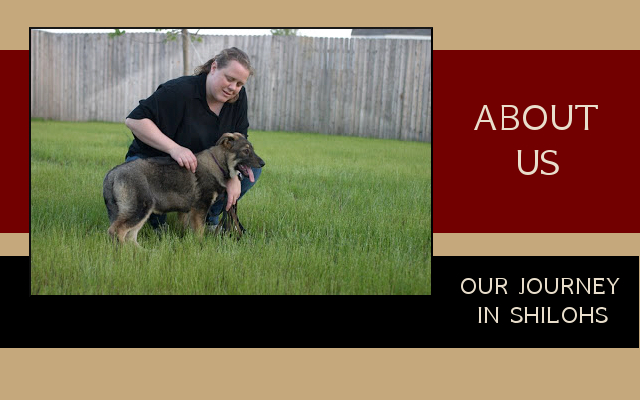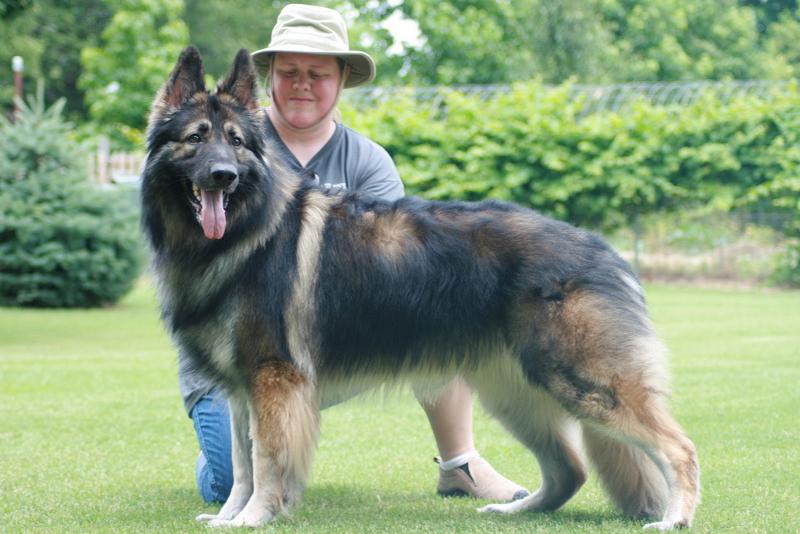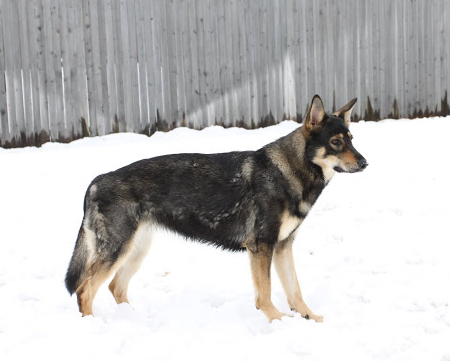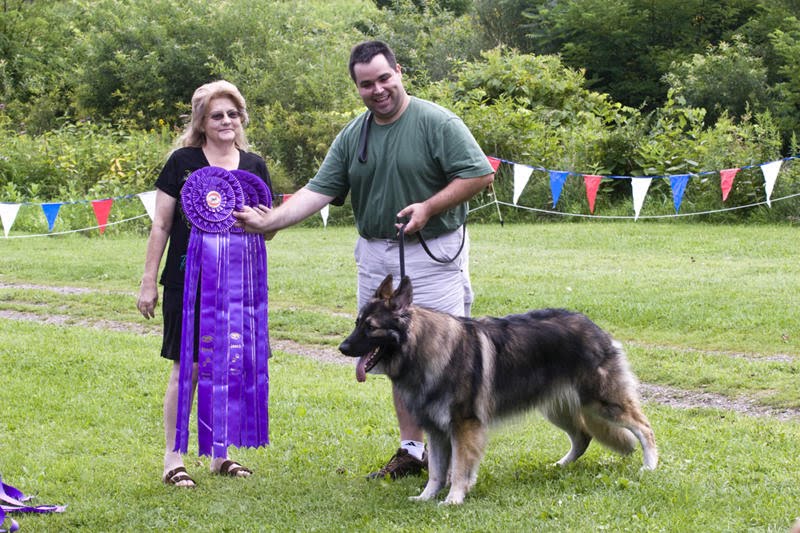
Shiloh Beginnings: From Tina's Dream to Our Reality
The Shiloh Shepherd Story starts out like this:
"The year was 1974. I was in a converted barn in Palmyra, New York, working with a dog named Tammy, who I thought might make a good Schutzhund dog. She had passed to the point of where she was working with a decoy, and he was trying to agitate her—and succeeding. I thought Tammy had some potential. But at that moment my hopes were not too high. It was one of the lowest moments of my life."
These are the words of Tina Barber, the Breed Founder of the Shiloh Shepherd. In her book, Tina goes on to write about her abusive marriage, raising her young boys practically alone, and being her family's sole supporter. Like her father, mother, and grandmother before her, she'd been working with German shepherd dogs for years--but running into big problems. Not only were most working shepherd temperaments too hard to handle for the average family, but the breed in the 70's and 80's was suffering from lines riddled with hip dysplasia.
Tina notes, "…the problems with the German shepherd were too big for me to tackle alone. I was seriously considering giving up on dogs." Tina goes on to recount how she had brought her two-year-old son with her that day and left him playing with his toys while she worked with Tammy. Then, as Tammy went for the decoy in a frenzy of snapping teeth, her son ran up out of nowhere, and grabbed the dog. "It all happened so fast there was nothing I could have done to stop it. There is no way that a dog in that state of frenzy could be expected to do anything but bite Johnny…" She had seen dogs that would get so worked up they would bite anyone, even their handlers.
But not Tammy. Tammy just stopped. "Instinctively Tammy knew the difference between an enemy and a child, and she knew how to switch gears in a fraction of a second. I hadn't seen that kind of reaction from a dog since I was in Germany." That moment, when she was at her lowest, was when Tina had the first inkling of what her life's work was to be. She embraced it. "I don't care about what the public thinks,” she wrote. “…this is the way I'm going to go."
And the rest, so they say, is history. Out of Tammy's line came the main foundation dog behind the Shiloh Shepherd: Shiloh's Kara Lobo of Emmview, aka Kari. Even to this day, over forty years from that day in the Palmyra barn, many Shiloh Shepherd breeders still track the percentage of Kari's blood in each breeding match they consider.
In 2007 my then-husband Zak and I purchased our first house. The logical step afterward seemed to be to look for a dog. We wanted a breed that would be good with other animals and small children, because we had one and were aunt and uncle to the other. We didn't want a breed that was too hyper, because we were both pretty low-key.
We discussed the merits of various breeds we liked, and found that we both loved German shepherd dogs. When I was a child I had shown obedience and Junior Showmanship in our local 4-H dog training project, and had fallen in love with a dog in the class, a sable German shepherd girl named Ellie. But even as a kid I had heard about the hip problems in the breed, and we didn't want a very high-energy or high-drive dog.
Reality also brought us up against the quandary of who to trust. You could easily pay over $3000 for a quality German shepherd, but how did you find a good breeder in that world—one who would guarantee the health of the pup, and who would be able to set us up with the dog that was right for our home? We had no clue.
So instead we decided to look at some of the breeds that were similar to German shepherds in appearance. King shepherds (which we later found out were originally Shilohs before their breeder split off from Tina's organization and crossed in other breeds). Belgian Tervurens. Weeks passed and we continued to talk, surfed for dog info on the internet, and picked up dog books at Barnes and Noble to page through them. Some, like Bruce Fogle's Encyclopedia of the Dog, followed us home.
It was there that we saw our first photo of a Shiloh Shepherd. In the book Bruce mentioned Tina as Breed Founder, and Zak said, "I wonder if she's still alive?"
Not only was she still alive, she was still breeding. And over the course of over thirty years of breed development she had produced an impressive number of web articles, booklets and documentation behind her dogs and how the Shiloh Shepherd came to be something different from a German shepherd.
Tina Barber started out with German shepherds. Why did she consider leaving the AKC? In The Shiloh Shepherd Story, she writes: "By this time I'd had twenty-eight years of experience with the American Kennel Club. Not all of it was good experience. … The AKC was not adequately monitoring genetic defects in dogs, and they allowed anyone to receive full breeding rights on any dog they owned, regardless of genetic faults."
Tina goes on to talk about how the changes in her dogs, changes she had worked hard to achieve, made her think that the AKC was no longer for her Shilohs. Changes in temperament, top line and other conformation were making the Shiloh shepherd very different from what most GSD breeders were producing. In addition, Tina had tracked a vast amount of data on her lines over more than a decade of work.
What it came down to was that the AKC GSD was too large to control. It was impossible to enforce standards for tens of thousands of dogs around the world! And in many ways it still is. Today's AKC breeders, with the exception of a few breeds, most often work on their own, with a mentor, or together in small groups.
However, only when a majority of breeders work together can they make an impact on the overall health and quality of a breed. Otherwise people simply continue to work at cross-purposes to each other…sometimes to the detriment of the health, structure, and genetic diversity of their dogs.
Tina wrote, "The reason I had kept such detailed records for so many years was so we could know exactly what we were dealing with. The Shiloh Shepherd could not retain the qualities I was striving for if people kept adding in dogs without the huge amount of … data required for a Shiloh. I had to think of another plan."
That plan involved splitting away from the AKC. Taking the Shiloh kennel German shepherd lines that were working well together, Tina would add in outcross dogs Sabrina (Sarplaninac lines) and Samson-Woo (Malamute lines) around 1990. The FIC recognized the Shiloh Shepherd (named for its kennel of origin) in September of that year, and Tina would found the Shiloh Shepherd Dog Club of America in 1991.
We spent days reading Tina's articles. Zak got on the phone with her, and was impressed enough to sign us up. I couldn't believe the amount of knowledge and care that went into the program that Tina had started. This was the sort of thing that people talked about, but that in the same sentence concluded could never exist.
First there was the care that went into the litter planning—these breeders didn't match two dogs just because they were pretty. Every litter required a COI report on how related the dogs were, the percentage of the blood of key dogs in the pedigree, and an analysis of the dogs behind the parents to turn up possible issues. Tina reviewed every match herself before approving it to go forward.
Then there were the testing rules. Every litter of pups went through a series of tests for temperament and conformation called an LER, or Litter Evaluation Report, at eight weeks of age. These tests were used to find the perfect homes for each pup. And then, at a year, breeding animals were required to pass not only a battery of health tests, but also adult temperament testing before receiving breeding papers.
A quick perusal of the website for the Orthopedic Foundation of Animals showed that Shilohs had significantly better hips than we had expected. Tina's Litter Mate X-Ray (LMX) program called for as many pups as possible in a litter to be x-rayed for hips as adults, even if they were pets. Because she was not looking only at breeding animals, Tina was able to see which dogs were likely carrying hip dysplasia based on how their litter mates' hips were, even if they had excellent hips themselves.
People who wanted to breed Shilohs in Tina's organization had to either do so under the supervision of a Licensed Breeder mentor, or they had to go to "school"—there was an online forum where Tina and the other breeders would instruct you for a minimum of three years before you were considered okay to make your own breeding decisions. This was the kind of dog breeding program I had thought couldn't possibly exist--driven by regulations, the study of genetics, and teaching the next generation of breeders WHY it was all important to the future of the dogs. Not just for a few breeders. For ALL breeders.
Tina had a waiting list, but we were on for a pup in fall or early winter.
Toward the end of her life, Tina published an article online about her breeding program. "I didn't set out to develop a 'breed'. I was just determined to develop the type of puppy I needed for my training program: great hips, highly intelligent, protective but inherently gentle… My breeding program began before there was a breed standard other than in my head. The Shiloh was and is so unique, it sold itself. Thanks to other dedicated Shiloh Shepherd breeders, it evolved into a magnificent breed, today known around the world as the Shiloh Shepherd."
In December of 2007 our Leo came to live with us. I didn't really know it, but my life was about to swing full circle. Dog-crazy as a kid, I had never really found "The Breed" for me. After college I had become convinced that dogs were too much work. But I didn't reckon on the breed I had been secretly imagining falling into my lap after almost two decades.

Leo was an astonishing puppy, super-easy (well, once he got used to his new crate), housebroken almost instantly and so intelligent that I could teach him new commands and words almost effortlessly. We were definitely hooked on the breed.
Then Kyrie went up on Tina's web site…a breed-quality female. Well. Were we ready for this? Apparently we were. Kyrie came to live with us, and became my heart dog. I lost her at the end of 2020, just a couple weeks short of her thirteenth birthday.

That year, back in 2008, we drove all the way from Texas to New York with our dogs to attend the annual Homecoming, a fantastic Shiloh Shepherd gathering that included everything from training seminars to the National show. Tina encouraged us to put him in the ring, and Leo brought home his first Best in Show at ten months of age! We met so many fellow Shiloh owners, both new and old. Like us, they loved all the work, education and care that went into the dogs. Many of these people are still our good friends today.

Zak and I enrolled in the Licensed Breeder training program. Mentored by the Breed Founder herself, as well as many more knowledgeable and reputable breeders, we came to understand what it meant to really take responsibility for the development of a breed of dogs.
Unfortunately, time brings an end to everything. Tina passed away on Memorial Day in 2011, shortly after our first litter of pups entered the world. I began writing this introduction because I foresaw a day when maybe all of her old web sites—all those places where Zak and I had devoured word after word about a truly unique breed of dogs—might also disappear.
So, this web site, and the ISSA web site that I created for our new club in 2016 (you can see that at www.shiloh-shepherd.com), are my ongoing effort to share with you all I have learned about this breed in the last ten years, from Tina herself and from other knowledgeable Shiloh shepherd breeders. I have gone from new owner to club member to Licensed Breeder, Puppy LER evaluator, and Temperament Tester. I serve now on the national Board of Directions of the International Shiloh Shepherd Alliance (ISSA). Here we strive to keep alive the core values of Tina’s old organization, while working with advances in genetic science to preserve this breed that we love.
Even if you decide that a Shiloh Shepherd is not for you, I hope in these sites you will come to see what a unique breed this is—-and, in the ISSA, still shepherded by a breeding program like nothing else on Earth.
--Anne Becker
Sparta Shiloh Shepherds
Denton, Texas
July 2017